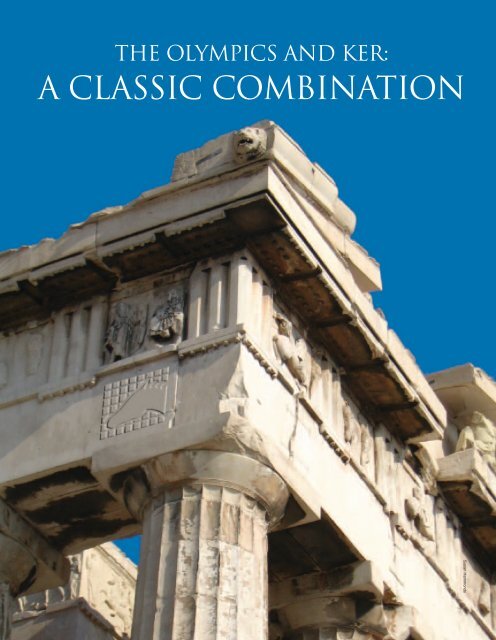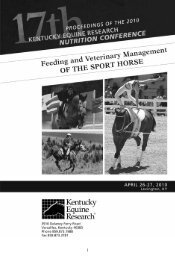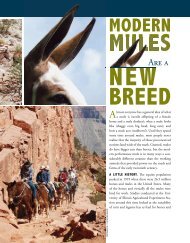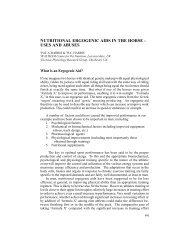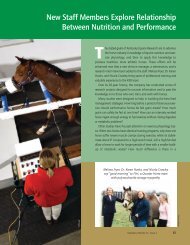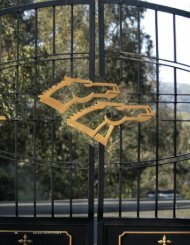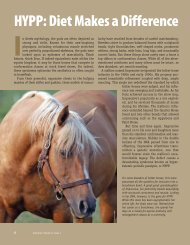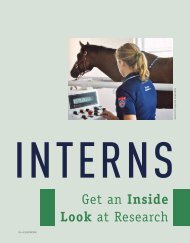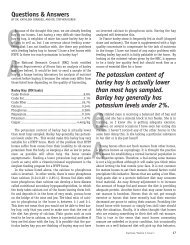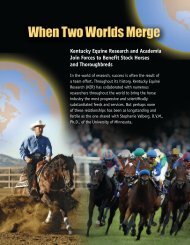The Olympics and KER: A Classic Combination - Kentucky Equine ...
The Olympics and KER: A Classic Combination - Kentucky Equine ...
The Olympics and KER: A Classic Combination - Kentucky Equine ...
Create successful ePaper yourself
Turn your PDF publications into a flip-book with our unique Google optimized e-Paper software.
<strong>The</strong> <strong>Olympics</strong> <strong>and</strong> <strong>KER</strong>:A <strong>Classic</strong> <strong>Combination</strong>Susan Hammonds
“Tomorrow, maybe.”“It’s difficult.”“It’s a problem.”For <strong>Kentucky</strong> <strong>Equine</strong> Research (<strong>KER</strong>)employees deployed to Athens for the2004 Olympic Games, these statementsbecame oh so familiar. <strong>The</strong> Greeks were sofond of offering these succinct answers toquestions that occasionally more thanone was used in a single brief exchange.While the Greeks proved competent hostson most fronts, officials were not alwaysthe most accommodating or proactivewhen problems arose, owing perhaps tothe usual laid-back European attitude. Tothose <strong>KER</strong> employees that helped withthe Olympic Games in Sydney, this philosophystood in stark contrast.In Sydney, one was more likely to hear“No worries, mate” or “Good as gold.”Despite the laissez-faire attitude of theGreeks, <strong>KER</strong> met the dem<strong>and</strong>s asked of itby providing high-quality products forthe 200 horses that participated in theOlympic Games <strong>and</strong> many more that wereinvolved in the Paralympic Games.Feeds supplied by <strong>KER</strong> included hay, pelleted <strong>and</strong> texturedconcentrates, straight grains (such as oats <strong>and</strong> corn),<strong>and</strong> chaff.Grass hay was the most popular choice of forage amongcompetitors. Three ocean containers, each with an approximatecapacity of a common highway trailer, held doublecompressedbales of grass hay. In order to save space in theocean carriers, the hay was packed tightly <strong>and</strong> bound. Oncecompressed, the bales were slightly larger than a desktopcomputer monitor, but their weight was deceiving, as eachweighed over 50 pounds. When the twine was cut, thebales sprang open, nearly tripling in size. Unlike grasshays, alfalfa cannot be compressed, so this legume foragewas shipped in st<strong>and</strong>ard bales.<strong>The</strong> grass <strong>and</strong> alfalfa hay secured by <strong>KER</strong> was of suchsubstantial quality that many people in the European contingentbacked away from it, preferring their own hay.Mike Lennox, <strong>KER</strong>’s formulation <strong>and</strong> quality assuranceexpert, explained, “Many felt it was too rich for their horses,which were more accustomed to forages with lowernutrient content.”More than ten tons of prepared feed were shipped fromthe United States to Athens just prior to the Games. <strong>KER</strong>Team Member Pennfield Feeds of Lancaster, Pennsylvaniamanufactured the three feeds that were specially formulatedfor the <strong>Olympics</strong>: Markopoulo High Performance Mix,Shawn HamiltonJulie Richards of Atlanta, Georgia <strong>and</strong> Jacob Two Two, a 16-year-old Canadian Thoroughbredgelding, are members of the silver-medal winning three-day event team. Jacob Two Two ismaintained on feed provided by <strong>KER</strong> Team Member Flint River Mills.Markopoulo Cool Mix, <strong>and</strong> Markopoulo Performance Pellets.Adding to that manufactured by Pennfield, five tons ofprepared feed from Irel<strong>and</strong> <strong>and</strong> 10 tons from Engl<strong>and</strong> werealso shipped to the Olympic venue. Feeds from Irel<strong>and</strong> weremixed by <strong>KER</strong> Team Member Bluegrass Feeds of CountyTyrone, <strong>and</strong> Saracen Feeds of Kent, another <strong>KER</strong> TeamMember, was one feed provider from the United Kingdom.As one can imagine, the horses competing in Athensreceive top-notch care, <strong>and</strong> this star treatment extended tothe bedding on which they rested. More than 5,000 bales ofabsorbent, dust-free shavings from Allspan, a German manufacturer,were used. Though shavings were the bedding ofchoice, <strong>KER</strong> arranged for two ocean containers of bright,clean straw to be in Athens.Organizing <strong>and</strong> executing the transport of tons of feeds<strong>and</strong> hay from several countries would have been a dauntingtask for many companies. For <strong>KER</strong>, however, it wasbusiness as usual: supplying the world’s best feeds to theworld’s best athletes.Sponsored Riders Medal in AthensNutrition is an important consideration when caring forany horse. Precision feeding is especially pivotal whenpreparing horses for an international competition, especiallya richly historic event such as the <strong>Olympics</strong>. Several<strong>Equine</strong>ws/Volume 7, Issue 4 7
medal-winning Olympic mounts were fueled by feeds formulatedby <strong>KER</strong> <strong>and</strong> manufactured by <strong>KER</strong> Team Members.<strong>The</strong> United States three-day eventing squad was composedof Kim Severson, John Williams, Julie Richards,Darren Chiacchia, <strong>and</strong> Amy Tryon. <strong>The</strong> eventing teamearned a bronze medal, finishing behind France (gold) <strong>and</strong>Great Britain (silver). In individual competition, Seversonof Keene, Virginia was awarded a silver medal, just missingthe gold medal by less than one point. She rode her longtimepartner Winsome Adante, an eleven-year-oldThoroughbred gelding owned by Plain Dealing Farm ofScottsville, Virginia.Three of these riders—Severson, Williams, <strong>and</strong> Richards—regularly feed concentrates mixed by <strong>KER</strong> Team Members. Horsesridden by Severson <strong>and</strong> Williams are maintained on feedscreated by Pennfield Feeds of Lancaster, Pennsylvania, <strong>and</strong>Richards’ horse stays fit on feeds supplied by Flint RiverMills of Bainbridge, Georgia.Other <strong>KER</strong>- or Team Member-sponsored riders that competedin Athens include Olivia Bunn (three-day eventrider from Australia), Phillip Dutton (three-day event riderrepresenting Australia), Matthew Grayling (three-dayevent competitor from New Zeal<strong>and</strong>), <strong>and</strong> Ricky MacMillan(dressage rider representing Australia). Marita Hird, a <strong>KER</strong>Australasia ambassador, competed for her country in theParalympic Games, held after the Olympic Games.<strong>KER</strong> Archives<strong>KER</strong> Sends Workforce to AthensProviding feed <strong>and</strong> bedding for the equine athletesthat competed in Athens was a formidableundertaking. While planning for the event beganmonths prior to the Games, <strong>Kentucky</strong> <strong>Equine</strong>Research (<strong>KER</strong>) provided considerable manpowerin Greece. More than 15 employees <strong>and</strong> friends ofthe American <strong>and</strong> Australian divisions of <strong>KER</strong>were on h<strong>and</strong> to help take feed <strong>and</strong> beddingorders, distribute products, <strong>and</strong> troubleshoot.Most of the workers spent two weeks in Greece,but some stayed several weeks to ensure feed <strong>and</strong>bedding requests were filled accurately <strong>and</strong> in atimely manner.Pictured to the right are several of the peoplethat made the journey to Greece. Of note is thenumber of countries these <strong>and</strong> other employeesof <strong>KER</strong> that helped in Athens represent: UnitedStates, Canada, Germany, Spain, Australia, GreatBritain, <strong>and</strong> Irel<strong>and</strong>. From left to right, front toback: Eileen Phethean, Joe Pagan, FlorenciaArrambide, Delia Nash, Laurie Willet, GwynneOvertoom, Susan Hammonds, Jaye McCracken,Karen Lemming, Fiona Deppeler, Mike Lennox,<strong>and</strong> Joanne Read.Other <strong>KER</strong> employees that worked in Athensbut are not pictured include Brian Lauer, ClaudiaLau, Emma Roberts, <strong>and</strong> Jeff Day.Susan Hammonds <strong>and</strong> Florencia Arrambide take a break fromtheir <strong>KER</strong> duties to enjoy the three-day event competition.Arrambide, who is fluent in several languages, boostedcommunication efforts between <strong>KER</strong> employees <strong>and</strong>representatives from throughout the world.8 <strong>Equine</strong>ws/ Volume 7, Issue 4
Supporting the Paralympic Games<strong>KER</strong> Archives<strong>The</strong> closing ceremonies of the Olympic Games did not signify the endof <strong>Kentucky</strong> <strong>Equine</strong> Research’s (<strong>KER</strong>) responsibilities. <strong>KER</strong> immediatelybegan to organize feed <strong>and</strong> bedding orders <strong>and</strong> deliveries for a secondgroup of horses: those that would carry riders during the 2004 ParalympicGames. <strong>The</strong>se Games, the ultimate competition for athletes with disabilities,attracted more than 4,000 contestants. Several of these competed indressage, the only equestrian discipline included on the roster.Events of the Paralympic Games were held in the same Greek venuesas their Olympic counterparts. <strong>The</strong>refore, the equestrian competitionswere contested at the newly built Markopoulo Olympic EquestrianCentre. <strong>KER</strong> staff was on h<strong>and</strong> during the Paralympic Games to supplygrain, hay, straw, <strong>and</strong> shavings to the competition horses.This year marked a pivotal moment in Games’ history, for it was thefirst time riders were given the opportunity to ride their own horses. Inprevious years, Paralympic equestrians rode horses supplied by localhorsemen, <strong>and</strong> riders were assigned their mounts r<strong>and</strong>omly.Below: American Kim Severson led the three-day eventteam. Coupled with her own medal in individualcompetition, Severson left Athens with two silvers.Florencia Arrambide<strong>Equine</strong>ws/Volume 7, Issue 4 9
Spectators had several opportunities to watch dressage at the Olympic Games.<strong>The</strong> three-day event competition featured two days of dressage competitionduring the beginning of the Games, <strong>and</strong> horses that specialized in the sportwere on display later in the festivities.<strong>The</strong> l<strong>and</strong>scape <strong>and</strong> architecture of Greece captivated thous<strong>and</strong>s of spectators<strong>and</strong> athletes at the Olympic Games. Many individuals left the adrenaline-filledatmosphere of Olympic venues to discover the beauty <strong>and</strong> tranquility ofoutlying towns.Susan HammondsFlorencia Arrambide
Florencia Arrambide<strong>The</strong> grassy galloping lane of the cross-country course wasa brilliant green. Stretches of grass such as those necessaryfor the speed <strong>and</strong> endurance phase of a three-dayevent are few <strong>and</strong> far between in Greece, so the trackwas laid especially for the Games. In addition to theextreme detail paid to the footing, the track featuredbeautifully designed obstacles with Greek themes.Susan Hammonds<strong>The</strong> azure waters surroundingGreece have lured travelersto the isl<strong>and</strong>s for years.Buildings such as this lookoutliberally dot the coastline<strong>and</strong> add to the charm ofthe country.A shade tent was part of theOlympic equestrian venue.Misting fans flanked the sidesof the open structure <strong>and</strong>provided relief for horses <strong>and</strong>grooms. With temperaturesbetween 95° <strong>and</strong> 100° F, thefans were a welcome attraction.Though temperaturessoared, humidity remainedlow, around 30-40%.Florencia Arrambide<strong>Equine</strong>ws/Volume 7, Issue 4 11
Who Let the Dogs Out?Most cities play host to the OlympicGames only once. Though Athens is deeplyrooted in Olympic history, the capital city ofGreece has not seen Olympic action in hundredsof years. As one can imagine, a hostcity cleans up its act a bit in anticipation ofthe athletes <strong>and</strong> countless spectators thatwill be on h<strong>and</strong> for the Games.For Athens, part of that cleanup includedrounding up nearly 15,000 stray dogs thatroamed the city streets. <strong>The</strong> Greeks took anovel approach to limiting future generationsof w<strong>and</strong>ering pooches. Instead ofeuthanization or relocation, officials keptthe dogs in confinement <strong>and</strong> all were eventuallyspayed or neutered. As Olympiccompetition wound down, the strays werereleased back into the streets. This time,though, each dog sported a bright red collaras well as a flea-control collar.Jeff RogersCourtesy of Charles Penny, UKMaintaining IntegrityIn Athens, every effort was made to ensure all Olympic events werecontested on a level playing field. <strong>The</strong> competitors in the equestrianevents, both human <strong>and</strong> equine, were to abide by stringent medicationrules <strong>and</strong> be completely free of prohibited substances.After <strong>Kentucky</strong> <strong>Equine</strong> Research (<strong>KER</strong>) agreed to provide feed <strong>and</strong> beddingfor the horses competing at the Olympic Games, it immediatelyrecognized the need to guarantee that all feeds supplied would be void ofbanned substances. <strong>The</strong> Fédération Equestre Internationale (FEI), thegoverning body of international equestrian sports, was contacted <strong>and</strong> anindependent laboratory in France, a recognized testing facility, was chosento test all feeds that were to be imported to Greece for the Games.In the United States, feeds are not routinely tested because raw products (cereal grains, oils, <strong>and</strong> by-products) are generallyconsidered innocuous because they are purchased from safe sources. In contrast, feeds in Europe are often testedfor impurities, primarily caffeine, theobromine, <strong>and</strong> morphine.Because of the worldwide prominence of the Olympic Games, <strong>KER</strong> requested that a complete battery of tests be completedon feed samples, at a cost of $90 each, to ensure they were not tainted with impurities that would elicit a positivedrug test in a horse. In addition to caffeine, theobromine, <strong>and</strong> morphine, all feeds supplied by <strong>KER</strong> were checked for sixother substances: theophylline, atropine, scopolamine, methylbufotenine, dimethyltryptamine, <strong>and</strong> bufotenine. Everysample submitted to the laboratory was considered clean.12 <strong>Equine</strong>ws/ Volume 7, Issue 4
Veggie Tales, Greek StyleAccording to the comprehensive Web site of the WorldCarrot Museum (carrotmuseum.com), carrots are second onlyto potatoes as the most popular vegetable in the world. <strong>The</strong>accuracy of this assertion is difficult to verify, but one thingis certain: among horses carrots rank first, without a doubt.So, when <strong>Kentucky</strong> <strong>Equine</strong> Research (<strong>KER</strong>) signed on to bethe official feed supplier at the 2004 Olympic Games, thecompany had to be sure an abundant supply of carrots wasavailable to satisfy the taste buds of the equine athletes.Carrots are grown throughout the world (China producesmore than any other country), including in certain regionsof Greece, so arranging for an ample quantity should nothave been difficult—one would think. But one mustremember the magnitude of this task. From past experience,<strong>KER</strong> knew thous<strong>and</strong>s of pounds of carrots wereneeded; in 2000, horses competing at the Sydney OlympicGames devoured over 22 tons of carrots! On this occasion,the supplier <strong>KER</strong> tapped was not a European vegetableconglomerate or a Manchurian taproot wholesaler. No, <strong>KER</strong>decided on a local—a very local—produce broker.To an outsider, acquiring the daily allotment of carrotsmay have looked somewhat surreptitious. Because accreditationcould not be ascertained for the produce merchant,<strong>KER</strong> employees arranged to meet him outside of the securestabling area. Each morning just before daylight <strong>KER</strong>employees drove an all-terrain vehicle (ATV), with trailerin tow, outside the entrance of the stabling area <strong>and</strong> waitedfor headlights to slice through the morning fog. <strong>The</strong>seheadlights invariably belonged to a small, beat-up truckthat cradled its cargo within slatted racks. <strong>The</strong> truck,heavily leaden with carrots, coughed <strong>and</strong> sputtered its wayto the parked ATV, <strong>and</strong> two Greek men eventually emergedfrom the cab, one directing the other to transfer the carrotsfrom the pickup to the trailer.Once all of the 45-pound bags had been shifted from onevehicle to another, the haggling began. “At this point,”said <strong>KER</strong> employee Eileen Phethean, “the communicationbarrier became an obstacle.” <strong>The</strong> price of the carrotswas not the same from day to day due to varyingquantities. Without a common language, theolder Greek man would whip out a wad ofpaper money from his pocket <strong>and</strong> peel off the numberof bills he expected in return for the carrots.After the carrots had been successfully transportedto the warehouse, they were removed from plasticbags, allowed to dry, <strong>and</strong> placed in mesh bags purchasedfrom a nearby hardware store. <strong>The</strong> mesh bags,similar to ones that the produce at groceries is packagedin, allowed the vegetables to remain fresh for longer periodsof time.Freshness may have been an unfounded worry, however,as carrots proved to be a hot commodity among riders <strong>and</strong>grooms. In fact, the dem<strong>and</strong> for carrots throughout theequestrian venue far outweighed the supply each day.Orders for carrots were so large that the vegetables had toEileen PhetheanA local vegetable merchantsupplied carrots for Olympic horses.be distributed judiciously, with few people ever receivingas many as they desired. <strong>The</strong> final tally reveals that morethan 20,000 pounds of carrots were purchased for thehorses competing in Athens.<strong>KER</strong>’s commitment to the 2004 OlympicGames went beyond providing customarymenu options for the equine palate.In addition to hay <strong>and</strong> grain, <strong>KER</strong>found a way to get literallytruckload after truckload ofcarrots to some of theworld’s most accomplishedequine athletes.<strong>Equine</strong>ws/Volume 7, Issue 4 13
Invest inSuccess!UseTM• Unsurpassed vitamin E nutrition forhorses of all ages.• Contains a minimum of 500 IU/mlof natural vitamin E as d-alphatocopherol.• Water-soluble formula is readilyabsorbed.• Ideal for foals, broodmares, <strong>and</strong>performance horses.Call 800-772-1988for more information.Sold through veterinarians only.Marketed by:Water-Soluble Natural Vitamin Ew.s.TMIntended as an oralvitamin E supplementfor horses of all classesGuaranteed analysisContains a minimum of500 IU per ml of vitamin EIngredientsVitamin E as d-alphatocopherol,polyethoxylatedcastor oil, water <strong>and</strong>n-propyl-alcoholOral solution foranimal use only.Not for human use.Keep out of reachof children.236 ml (8 oz)11-291P.O. Box 1013, Versailles, KY 40383www.kentuckyperformanceproducts.comDEVELOPED BY KENTUCKYEQUINE RESEARCH14 <strong>Equine</strong>ws/ Volume 7, Issue 4
Reprint Courtesy of<strong>Kentucky</strong> <strong>Equine</strong> Research, Inc.3910 Delaney Ferry RoadVersailles, KY 40383Phone: 859-873-1988Fax: 859-873-3781Order Department: 888-873-1988www.ker.cominfo@ker.com


